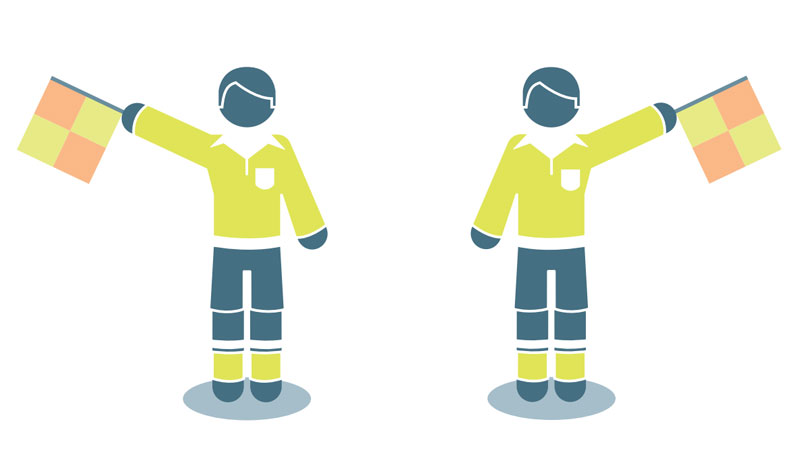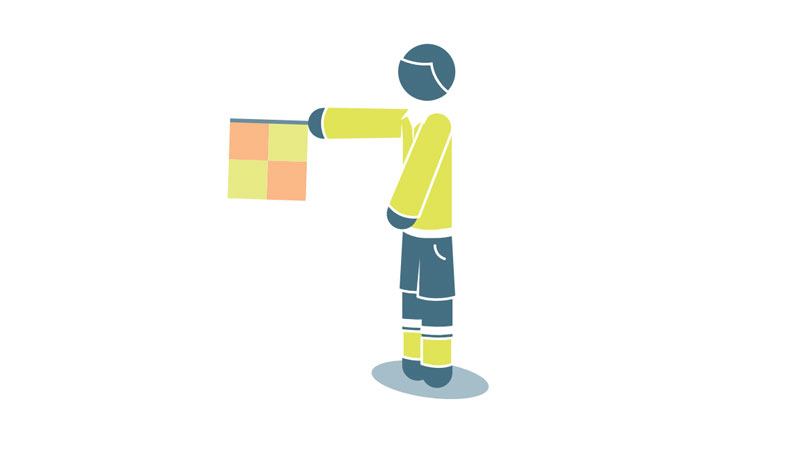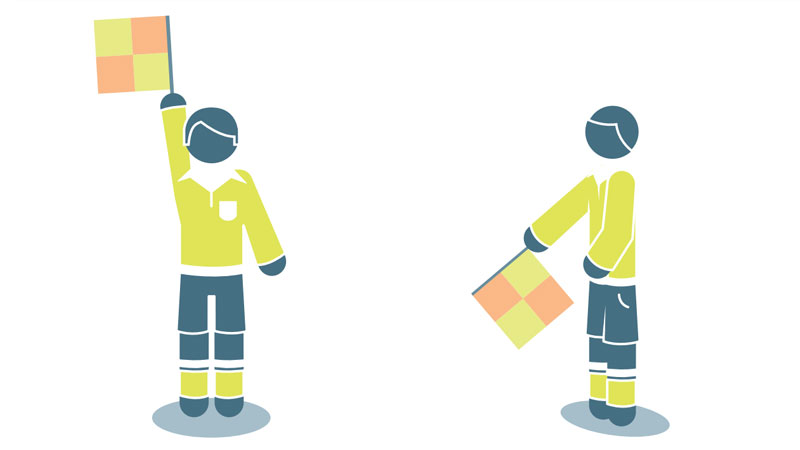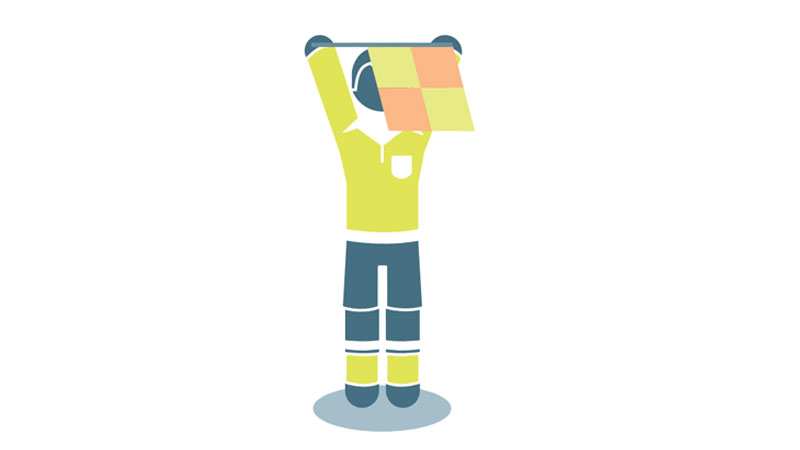Authority Soccer (authoritysoccer.com) is a participant in the Amazon Services LLC Associates Program, an affiliate advertising program designed to provide a means for sites to earn advertising fees by advertising and linking to Amazon.com. This site also participates in other affiliate programs and is compensated for referring traffic and business to them.
Referees are a huge part of soccer; without them, the game could not exist. During a match, there is more than just one referee who can make decisions; they have help in the form of the assistant referee.
We will now look at all the signals that assistant referees make during a soccer game and how they motion each other to the main referee.
The flag of the assistant referee has to be always visible to the main referee. It must be unfolded and as still as possible, even when the assistant is running.
When there is a signal to be made, the assistant has to stop running, turn and face the referee, make eye contact, and then raise the flag on purpose but not in a silly way so that it gets the attention of the main referee.
They say that the flag should be an extension of the assistant’s arm when used.
The assistant has to put their flag up by using the hand that is going to be used for the signal that is to come next.
However, if that can not happen, then the assistant’s other hand has to be used for the signal that is to come next. The assistant should then change the flag to their opposite hand and have the flag down below their waist.
The assistant referees must raise the flag using their hands, which will also be used for the next signal in a sequence.
If circumstances change and the other hand must be used for the next signal, the assistant referee should move his flag to the opposite hand below the waist.
We will look at all assistant referees’ signals during a match.
Throw-In

During a game, when the soccer ball goes out of play near where the assistant is standing, they must then signal to the players and the main referee which direction the throw-in should go (which team takes the throw).
When the soccer ball goes out of play when the assistant is not near it, and it is clear which team will get the ball, the assistant will make a direct signal to show both players and the referee which way the throw-in will go.
Suppose the soccer ball goes out of play, and the assistant is far from where it crossed the line. In that case, the ball still looks like it is in play, or if there is any doubt in the assistant’s mind, they have to raise their flag to tell the main referee that the ball is out, look at the main referee and then follow the referee’s signal.
Goal Kick

When the soccer ball goes out of play (goal line) and is close to the assistant referee, they must signal with either their left or right hand to tell the referee and players that it is a goal kick.
If the soccer ball crosses the goal line and it is close to the position of the assistant however, the ball still looks to be in play; the assistant has first to raise the flag to tell the referee the ball is not in play and then to imply that it is a goal kick.
If the soccer ball happens to cross the goal line and the assistant’s position is far from where the ball crossed, they have to raise their flag to tell the referee that the ball is now out while making eye contact and then follow the main referee’s decision. The assistant can also signal if it is deemed that the decision is a clear call.
Corner Kick

When the soccer ball goes out of play (goal line) and is close to the assistant referee, they must signal with either their left or right hand to tell the referee and players that it is a corner kick.
If the soccer ball crosses the goal line and it is close to the position of the assistant however, the ball still looks to be in play; the assistant has first to raise the flag to tell the referee the ball is not in play and then to imply that it is a corner kick.
If the soccer ball happens to cross the goal line and the assistant’s position is far from where the ball crossed, they have to raise their flag to tell the referee that the ball is now out while making eye contact and then follow the main referee’s decision.
The assistant can also signal if it is deemed that the decision is a clear call.
Offside

The first thing the assistant referee has to do after they have deemed a player to be offside is raise their flag. The assistant will then use their flag to tell the main referee which area of the field the player was offside.
If the main referee does not see the assistant’s flag has been raised, then the assistant must keep the flag raised and continue to keep signaling until the main referee sees that the flag is raised or that the soccer ball is now in possession of the team that is now defending.
When the time comes for the assistant to raise their flag, it must be done with their right hand. Doing this gives the assistant a better sight of the field.
Substitutions

When soccer teams decide it is time to make some changes to their team during a match, they will make a substitution. When this happens, the person acting as the fourth official must first tell the assistant of this.
The assistant referee has to then make a signal to the main referee when there is a stoppage in play.
The assistant referee will not have to go to the middle of the pitch (halfway line) because the fourth official is charged with doing the entire substitution action.
However, if there is no fourth official present for the match, the assistant referee has to help with all of the substitution actions.
When this happens, the main referee has to wait until the assistant referee is back in their normal position before play can resume.
Fouls

The last signal that an assistant referee has to make is when a foul is committed on the pitch. When this happens, they must immediately raise their flag, and when the foul is committed out of the referee’s vision, they have to do so in such a way that the main referee can see the flag.
In other situations, the assistant referee has to wait until the main referee wants their opinion on a situation or if they are asked if they saw what foul was committed and by which player if the referee did not see it.
If that happens then the assistant referee has to report what they have seen or heard between the players that were involved to the main referee.
However, the assistant referee must clarify a few things before they can raise their flag.
First, the offense occurred out of the referee’s view, o was the view of the obstructed referee not having an advantage had they seen the foul in the build-up?
If there has been misconduct or a foul has been committed by a player, the assistant referee has to raise their flag with the same hand that is going to be used for the rest of the signal; this is because it gives a very clear sign as to which player was fouled.
The assistant referee also has to make eye contact with the main referee and when a foul is committed wave their flag back and forth to signal a foul has been committed and if necessary the assistant can use an electronic beep signal in which the main referee can then know that a foul has been committed.
Lastly, the assistant has to use the wait-and-see technique. This is to allow the play to continue and not put their flag up to indicate a foul when the team that had the player fouled has a distinct advantage.
When this happens, the assistant must maintain eye contact with the main referee.

